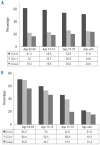Survival for older patients with acute myeloid leukemia: a population-based study
- PMID: 22773600
- PMCID: PMC3590098
- DOI: 10.3324/haematol.2012.066100
Survival for older patients with acute myeloid leukemia: a population-based study
Abstract
Background: Acute myeloid leukemia is the second most common leukemia among United States adults with a median age of 69 years. We investigated recent clinical practices related to treatments and disease outcomes in older patients with acute myeloid leukemia in the United States.
Design and methods: In this retrospective cohort study, we used Surveillance, Epidemiology, and End Results program data from 2000 through 2007 linked to Medicare enrollment and utilization data in the United States.
Results: Among 5,480 patients with acute myeloid leukemia (median age 78 years, range 65-93), 38.6% received leukemia therapy within three months of diagnosis (treated group). Practice changed with 16.3% of treated patients receiving hypomethylating agents after 2004 when those agents became available. Median survival was two months in the untreated group versus six months in the treated group (P<0.01) with the biggest improvements seen in those aged 65-69 years (10 months vs. 4 months; P<0.01) and 70-74 years (8 months vs. 3 months; P<0.01). In 46 patients receiving allogeneic hematopoietic cell transplantation (0.8%), the median survival from diagnosis was 22 months.
Conclusions: Therapy for leukemia improves overall survival in older acute myeloid leukemia patients. Based on their comorbidities, most patients up to 80 years of age should be considered for treatment. New therapies including hypomethylating agents and allogeneic hematopoietic cell transplantation are promising and must be compared with other chemotherapy regimens.
Figures



Comment in
-
The benefit of population-based studies for older patients with acute myeloid leukemia.Haematologica. 2012 Dec;97(12):1781-2. doi: 10.3324/haematol.2012.080242. Haematologica. 2012. PMID: 23204478 Free PMC article. No abstract available.
References
-
- American Cancer Society Cancer Facts and Figures 2011. Atlanta, Ga: American Cancer Society
-
- Juliusson G, Antunovic P, Derolf A, Lehmann S, Mollgard L, Stockelberg D, et al. Age and acute myeloid leukemia: real world data on decision to treat and outcomes from the Swedish Acute Leukemia Registry. Blood. 2009;113(18):4179-87 - PubMed
-
- Lerch E, Espeli V, Zucca E, Leoncini L, Scali G, Mora O, et al. Prognosis of acute myeloid leukemia in the general population: data from southern Switzerland. Tumori. 2009;95(3):303-10 - PubMed
-
- Alibhai SM, Leach M, Minden MD, Brandwein J. Outcomes and quality of care in acute myeloid leukemia over 40 years. Cancer. 2009;115(13):2903-11 - PubMed
-
- Juliusson G, Billstrom R, Gruber A, Hellstrom-Lindberg E, Hoglunds M, Karlsson K, et al. Attitude towards remission induction for elderly patients with acute myeloid leukemia influences survival. Leukemia. 2006;20(1):42-7 - PubMed
MeSH terms
LinkOut - more resources
Full Text Sources
Other Literature Sources
Medical

